Meg Mackintosh Solves Seven American History Mysteries (12 page)
Read Meg Mackintosh Solves Seven American History Mysteries Online
Authors: Lucinda Landon

“Let's take it over to that music shop,” said Peter, pointing across the street.
“I bet they could tell us if the letters are notes or not.”
“Good idea,” said Meg. “I'll tell Gramps we'll be right back.”
“This is an old tin horn,” the music shop owner told them a few minutes later. “There are letters etched on here, but they're difficult to read. Your sister was right. They're not the musical notes to play. I bet if I rub some of this mineral oil on the impressions, a message might appear.”
“The first letter has been practically worn off, but here it's coming up. It's âD'.”
“Then it spells âDanger',” said Peter, “not anger.”
“Why would he write âDanger' on his horn?” wondered Meg.
“Maybe the horn is from some military battle, and it warned soldiers about attacks from Apaches or something,” Peter conjectured. “Or maybe it's from the Civil War.”
“There's more, “ said the owner. “In much smaller letters underneath it says âcrossing the Platte.' And this mark in the middle looks like it was tied to something here because there's a slight dent.”
“Excellent detecting,” Meg told the owner. She pulled the ripped page from the diary and the tintypes out of her pocket to re-examine them.
“No one is wearing military uniforms in the photos.”
“I think I know what the warning at Scottsbluff was,” said Peter.
“Me, too,” said Meg.
What was the warning at Scottsbluff?

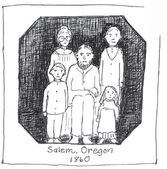
“Danger crossing the âPlatte'. The name âPlatte' sounds familiar,” said Meg.
“It's the name of the large river the wagon trains followed across Nebraska,” said Peter. “I saw it on the maps.”
“The wagons had to cross the Platte at certain points, and sometimes it was very treacherous,” the shop owner told them. “Sometimes wagons overturned or sank, and many people drowned if the currents were rough.”
“Drowned? That's awful,” said Meg. “And the rest of the family just had to keep going?”
“I'm afraid so,” the shop owner continued. “They often left grave markers along the trail.”
“Peter, remember the photographs? The whole family wasn't in the second one. I think the mother was missing. Something happened to her along the way,” said Meg. “Look at the diary page. I think he's writing about the awful event.”
“From the sound of this message written on the horn, I bet that's exactly what happened,” said Peter. “I think the horn was left behind as a warning to other settlers that passed that way â to beware crossing the Platte River at that spot.”
Why was it left on the horn?
Peter continued. “He wrote it on his tin horn because he knew it would hold up in all kinds of weather. He probably tied it to a stick and that's how it got indented in the middle. âDanger' â that was the warning at Scottsbluff.”
“There's a faint âJS' on the inside of the horn,” the owner pointed out.
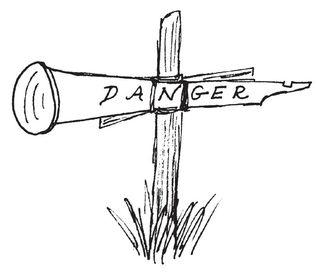
“That must stand for Jack Shaw,” said Meg. “That's got to be him in the old tintype â the boy who looks to be about our age. He left the signal to warn other families.”
Meg jotted in her notebook. “Maybe the diary page looked something like this,” she showed them.
“I think you should take this to the Oregon Trail Museum at Scottsbluff,” the owner suggested.“I can tell by the age of this horn and the rest of your information that this is an historically significant artifact.”
“That's exactly what we'll do,” Meg told him as they thanked her and headed out the door.
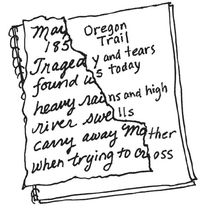
“First we have to find our grandfather and our own
covered wagon
,” said Peter.
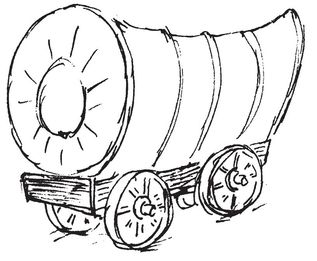
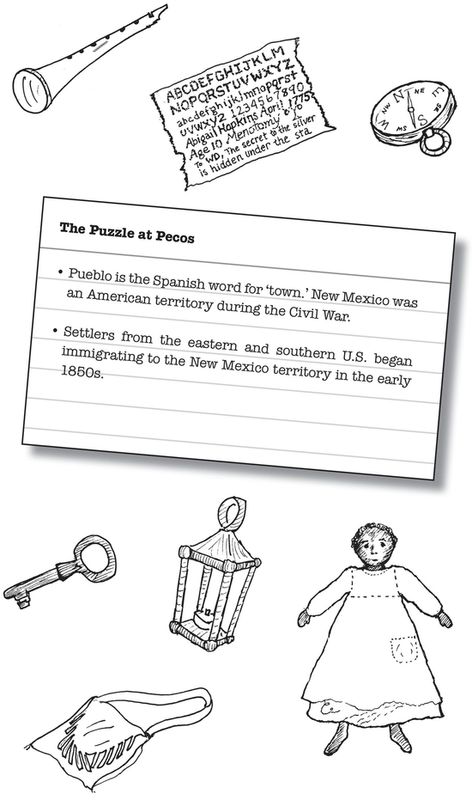
The Puzzle at Pecos
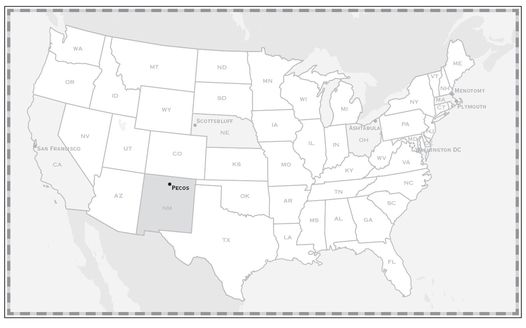
After spending the night in Wyoming, Meg Mackintosh, her brother Peter and Gramps awoke with a decision to make.
“We can continue directly west to San Francisco,” said Peter as he studied the map of the western United States. “Or we can go south through Colorado to New Mexico.”
“I say New Mexico first,” said Meg.“That way we'll finish up our history mystery tour on the West Coast. It seems appropriate to go from the Atlantic to the Pacific oceans.”
“Makes sense to me,” Gramps said, so they climbed into their minivan for a jaunt through the Rocky Mountains.
When they crossed into New Mexico, Gramps handed them the first clue for the next mystery,
The Puzzle at Pecos
.
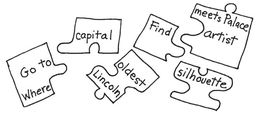
Peter opened the envelope and then sprinkled several small pieces of paper into Meg's hand. “Professor Brown wasn't kidding when he said âPuzzle at Pecos,'” Peter quipped.
Can you detect what the clue says?
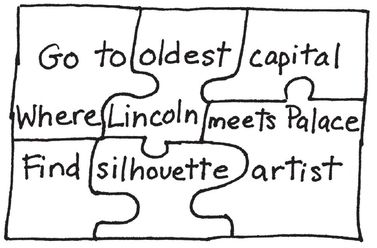
“Quick, let's piece it together,” said Meg.
“âOldest capital'? âWhere Lincoln meets Palace'? Are you sure this clue doesn't belong with Washington, D.C.?” Peter was confused. “What about Pecos? And what exactly are âsilhouettes'?”
“Silhouettes are outlines of objects. Silhouette artists cut portraits of people out of black paper,” Gramps explained.
“Wait a minute,” said Meg as she studied the guidebook. “Santa Fe is actually the oldest state capital because it was founded in 1609! That's even before Plimoth was founded!”
“And look on this map of Santa Fe,” Peter said. “I think I know where we should go first.”
Where in Santa Fe should they go?
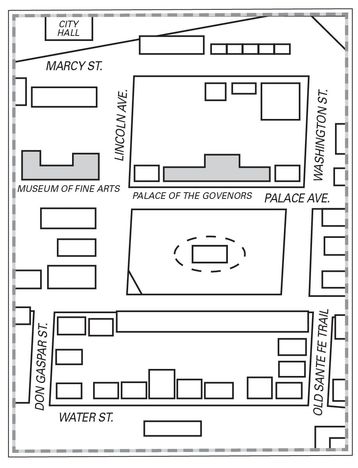
“The Palace of the Governors is on Palace Avenue. And there's the corner of Palace and Lincoln streets in the heart of old Santa Fe.That's got to be where we'll find the artist,” Peter told them.
“I bet you're right, Peter,” Meg agreed and she pulled out her notebook. “Do you have any idea which artifact this story is about and who the history mystery child is?”
“I don't know,” answered Peter. “I just found Pecos on the map. It's about 20 miles southeast of Santa Fe on the Old Santa Fe Trail.”
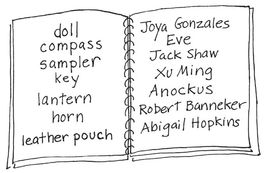
“We still have to find the artist in Santa Fe first,” said Meg. “Then we'll take it from there.”
Once they had driven into Sanfa Fe, Gramps parked the minivan, and they walked to the old Plaza downtown. There, they found the silhouette artist on the corner, just as Professor Brown had directed them.
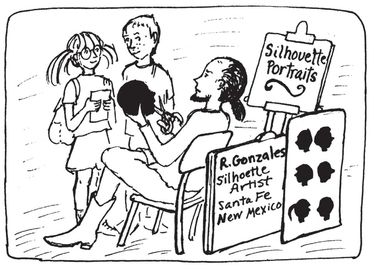
“May I do a portrait for you?” the artist asked them.
“Actually, we're here to ask you some questions about a history mystery,” said Peter. He showed him the list of history mystery children and artifacts. “Do any of these names or artifacts mean anything historic to you ?” he asked.
“Actually, I do recognize a name on your list. What's this all about?”
Which name do you think he recognizes?
Meg stared at the name on the artist's portfolio, then elbowed Peter.
“Joya Gonzales, that's my great-grandmother's name. Why do you have it on that list?” the artist asked, puzzled.
“Mr. Gonzales, we're trying to solve a history mystery that took place in Pecos, New Mexico. Did you ever meet a Professor Brown?” she asked.
“I don't recall ⦠but I've been working on this corner for twenty years. Perhaps he was one of my customers,” he replied. “But some of my family is from Pecos. It's not far from here.”
“Show him the artifacts,” Meg told Peter.
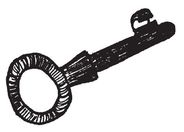
Peter dug into the knapsack and pulled them out.
“Do these mean anything to you?” he asked.
“I don't recognize the lantern,” Mr. Gonzales mumbled as he looked over the artifacts. He juggled the key back and forth between his palms. Meg held her breath. “This could be a key to anything,” he said.
Peter asked, “Can you tell us
anything
about your great-grandmother?”
“Not really. But my cousin still lives out at the family home. They operate a dude ranch. Would you like to go for a trail ride out to her place? I'll take you there. I'm done for today anyway.”
“Sure!” they agreed.
Mr. Gonzales packed up his easel and artwork.
“I think you're ready for the next clue,” said Gramps as he handed it over.
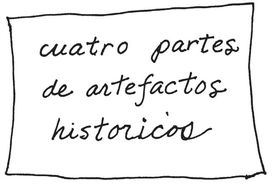
What does the clue say?
“I'm studying Spanish in school,” Peter said eagerly. He jotted own his translation of the clue:
“Four more artifacts? What's this all about?” Meg was confused.
On the way to the ranch, Meg and Peter looked up some historic facts about Pecos.
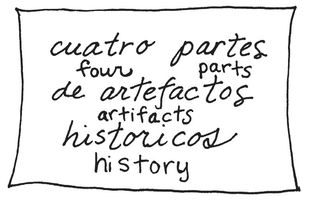
“There's a National Historic Park in Pecos, with lots of interesting exhibits,” said Meg, and she wrote some facts in her notebooks to bring along the trail.

